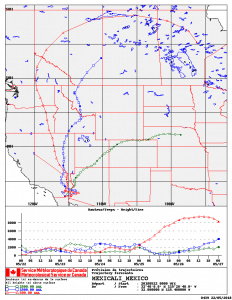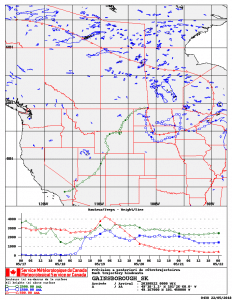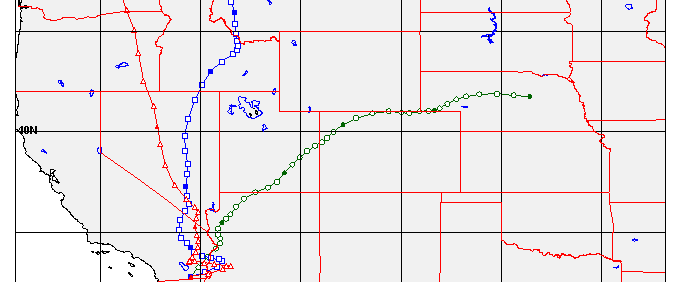

Prairie Pest Monitoring Network reports on two types of wind trajectory:
1. Reverse trajectories (RT) refer to air currents that are tracked back in time from specified Canadian locations over a five-day period prior to their arrival date. Of particular interest are those trajectories that, prior to their arrival in Canada, originated over northwestern and southern USA and Mexico – anywhere diamondback moth populations overwinter and adults are actively migrating. If diamondback adults are present in the air currents that originate from these southern locations, the moths may be deposited on the Prairies at sites along the trajectory, depending on the local weather conditions at the time that the trajectories pass over our area (e.g. rain showers, etc.). RTs are the best available estimate of 3D wind fields at a specific point. They are based on observations, satellite and radiosonde data.
2. Forward trajectories (FT) have a similar purpose, but the modelling process begins at sites in USA and Mexico. The model output predicts the pathway of a trajectory. Again, of interest to us are the winds that eventually end up passing over the Prairies.
PPMN Wind Trajectory Updates continue for the next 4-5 weeks and are generated over a 5-7 week period each spring synchronized to two important events:
1. The period when both diamondback moth (DBM) and aster leafhoppers (ALH) are moving north into the Canadian Prairies from more southerly sources, and
2. The period when suitable host plants start to become available on the Prairies (i.e., needed to sustain arriving DBM or ALH for feeding and/or oviposition and the start of the “new” generation).
NOTE: Wind Trajectories estimate potential arrival events, however, traps and in-field scouting confirm arrival dates. For example, DBM pheromone traps confirm arrival and, if deployed early enough AND checked frequently, can help define a “starting point” that can be used to try to predict the number of generations of DBM that may occur through the season (i.e., depending on environmental conditions that follow).
